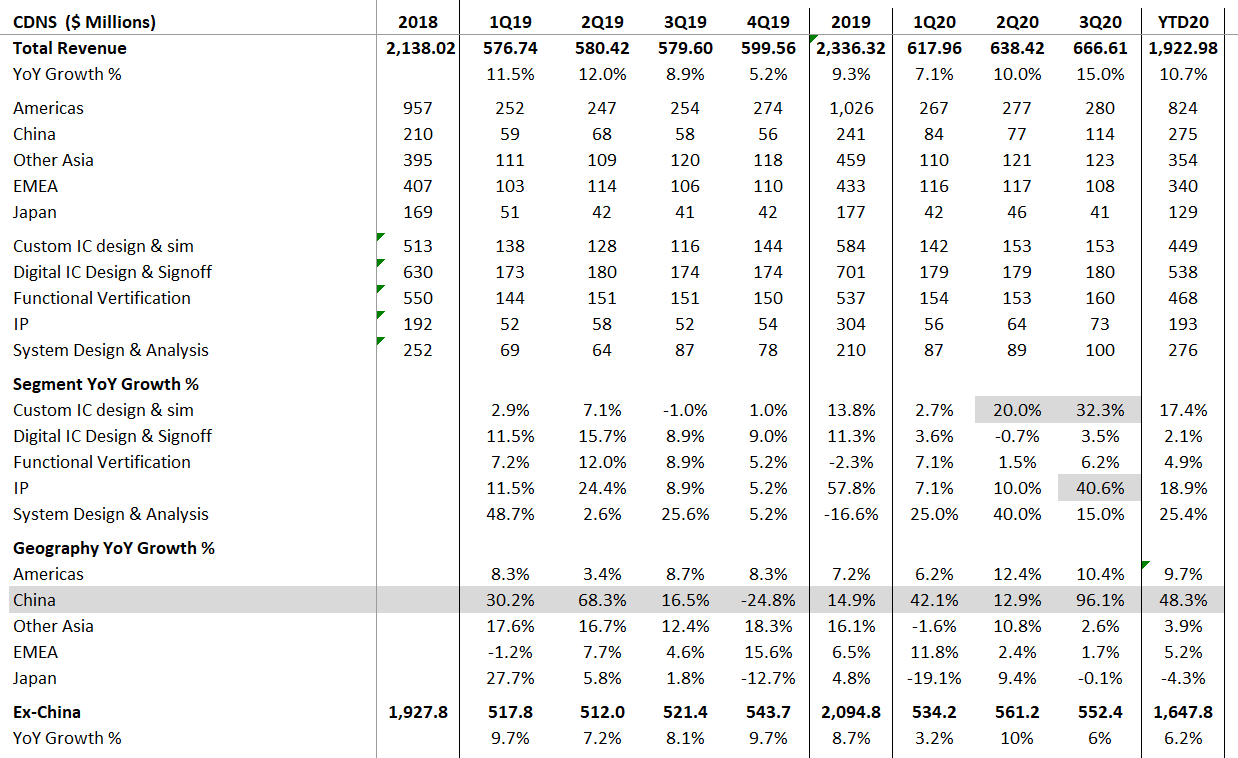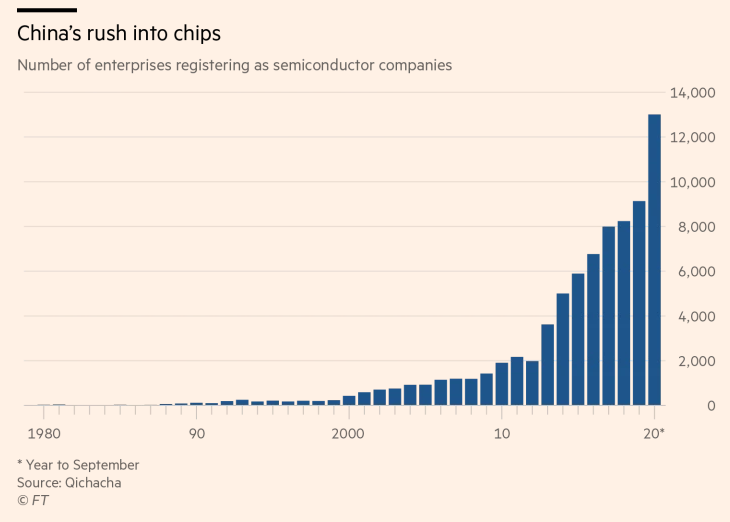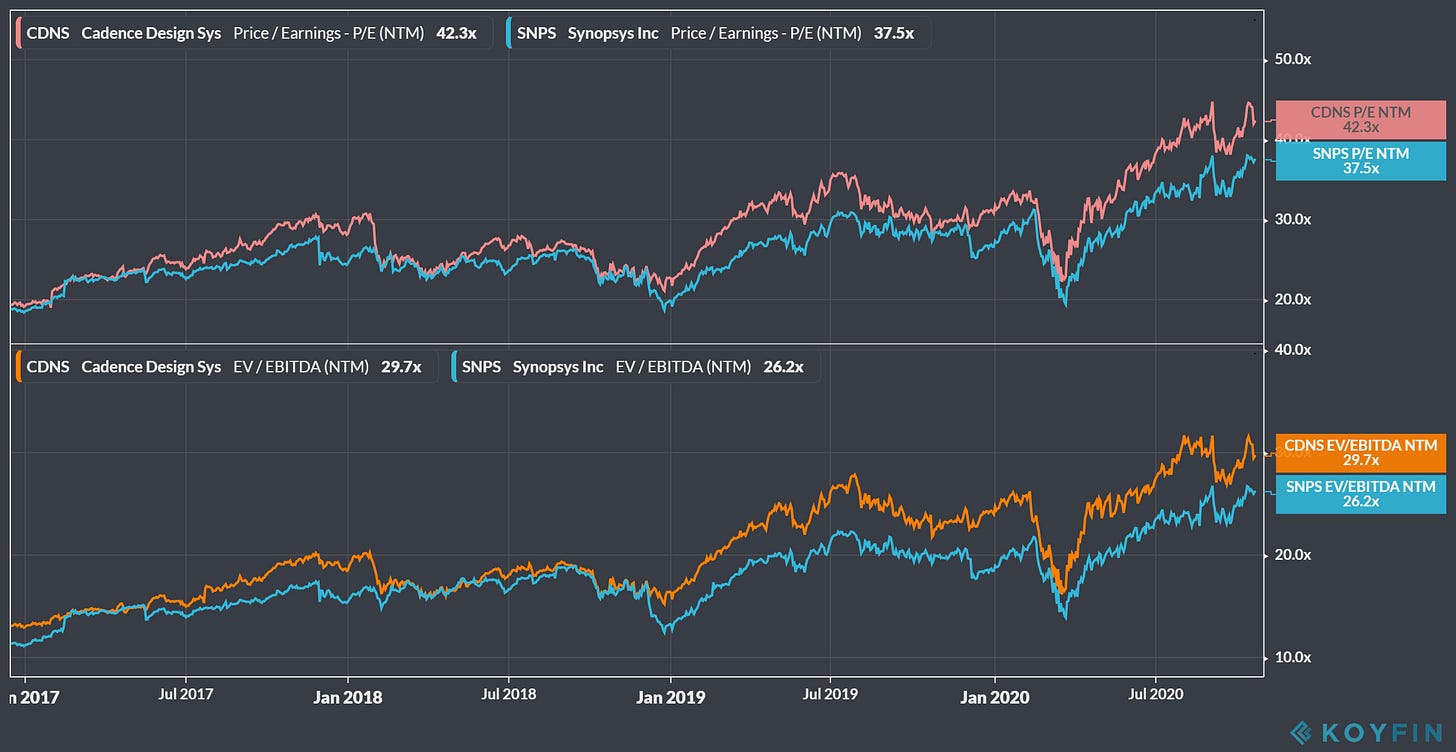

Discover more from Fabricated Knowledge
Cadence's China Quarter, Intel Divesting NAND, and Other Blurbs
Cadence’s China Quarter
Cadence pretty much had a blow out quarter.

This company is about as steady eddy as it comes - and always “beats earnings”. Of the last 20 quarters, they have beat earnings in 18 of them. So no “surprise” beat here.
Earnings and margins clearly dropped through in a way that shocked even me though, but despite the blowout earnings, the question on everyone’s mind on the call was “WTF is going on in China”.
I highlighted China's revenue for you - but this quarter in particular is a standout result compared to historical growth rates.

China has and always will grow faster than the corporate average, but the sequential revenue acceleration there is just really mind-boggling. 96% revenue growth! Why? Well, first we need some context of what exactly is going on in China for semiconductors right now. Enter the Big Fund.
The Big Fund and Distorted Markets
Compared to its Phase I that began five years ago, Big Fund Phase II is twice as big at 204.15 billion yuan ($28.9 billion), slightly exceeding market expectations. Phase II investment is anticipated to start as early as November this year.
The Big Fund first phase, which invested in 23 semiconductor companies, resulted in multiple mergers, acquisitions and IPOs.
Currently, the Chinese semiconductor industry is abuzz with speculation as to what the focus of the Phase II investment will be, and who among China’s chip players will benefit from the new phase of the Big Fund investment.
There are some clues, though.
At a September semiconductor industry summit, the Big Fund’s manager revealed that Phase II will focus on etching machines and film, test and cleaning equipment. The goal is to build an independent, self-sufficient and “controllable” industrial chain for the Chinese IC industry.
Source: https://www.eetimes.com/chinas-big-fund-phase-ii-aims-at-ic-self-sufficiency/
China’s Big fund is its domestic efforts to have a self-sufficient Chinese semiconductor market by 2025. And there is no surprise that it’s being spent like crazy, and it is allegedly terrible misspent already. But the fund is getting the results China wants, at least the kind you can measure.
This great FT.com article really puts things into context. They are calling this the “Great Semiconductor Leap Forward”. This chart in particular is nutty to me.

Clearly, some of this inflow of new entrants is finding it’s way to EDA companies, and will likely continue until the US government puts an export ban on EDA software. There is also an equity bubble in China for semiconductor companies to go along with this chart. Everyone’s seen the bubble forming, and now companies are rushing in.
Back to Cadence Earnings - Here are some tidbits that stood out to me.
On if Nvidia+ARM / AMD+Xilnix will impact them negatively
Yes. I think the -- let me try to answer that. And first of all, we are not able to comment on any speculations on the NVIDIA and ARM and then clearly, they are great company. And ARM is a very important partner for us, for Cadence, and we are well positioned with ARM to serve our common customers. I think clearly time will tell and I'll get approval and so I think that's on the NVIDIA and ARM. And then on the AMD and Xilinx, they are all very good companies and we like them a lot and clearly, over the years, we managed well through consolidations, and we are very proactive engagement with the companies. And then any consolidation, they are all unique respect to the vendor. They are all good company, and I think I cannot go beyond -- comment any beyond that.
Yes. I think consolidation, always, I pay attention to it, and we try to be proactive engagement for the acquirer or being acquired company, and we make sure that we are creating a win-win to continue business. And clearly, on all this consolidation, R&D is the last place they want to cut. So they're going to continue to drive innovation, continue to drive efficiency, and that's why we want to be a great partner for them. And so far, we managed well through consolidation in our customer base that have been taking place. And then each consolidation has their own unique way in terms of respect to vendors. But we are very respecting of what they try to do, and we try to be a great partner, work out a win-win, and we are very proactive with them.
On China Revenue impacts, where it flowed through, and why it helped margins so much this quarter.
Gary, that's a great question. The -- yes, in terms of China, the strength in China was higher than expected. We valued it at about $40 million. We think the second half of the year benefits from like $45 million for the extra 53rd week of revenue and probably $40 million for this kind of spike in China revenue that we believe is mostly nonrecurring revenue. But it's -- you saw that the China percentage is about 17% in Q3. That's 4% higher than the previous record level. And like I say, our valuation of that is about $40 million to the second half, split about 2/3, 1/3 between Q3 and Q4. But it's -- I understand the concern about is there a pull forward from next year? It's too early for us to say right now. What we can say is that, that extra revenue is generally and predominantly nonrecurring in nature, but I won't know until early next year when I look at the pipeline whether it impacts '21.
Yes, Gary, naturally, I mean, we're continuing to invest in R&D, but hiring was slower than expected in Q3. And also the pandemic is helping margins with a little less T&E. We seem to be creeping up into the like 33% to 34% range. We're probably at the high end of that range for as long as the pandemic helps us to keep certain expenses lower. But for Q3, we got an additional margin benefit of about 2% for that extra hardware and IP revenue in China, which is mostly nonrecurring and onetime in nature. I've assumed that continues into the middle of Q4, and we get about 1% extra benefit in Q4. And the extra week is actually about 0.5% of a headwind to margins in Q4, but yes, the baseline for margin is probably in the 33% to 34% range. And there are some onetime things that are helping us in Q3 and Q4.
Cadence of course did its absolute best to talk down the Chinese results. This company loves to manage expectations, and pointed out the 53rd-week comparison that will help them, and stressed that China is non-recurring. I think it is a bit more complicated than that. I think China will probably grow at meaningfully higher rates than the rest of the business and continue to have blowout quarters like this until the US government puts on stricter export bans. It is in Cadence’s interest to tamper with expectations as much as they can, but I think the China tailwind is durable until political intervention. It’s tricky.
Cadence is pretty much doing what it’s supposed to. It’s stable software that is charged on a per-seat basis that benefits from the R&D ecosystem broadly. It’s a functional duopoly, and despite its size, it continues to grow approximately in-line with its historical growth rates. It’s impressive, a bit on the expensive side (it always is) but it’s performing and well-positioned. For a context of valuation:

Also if you’re interested in a deeper dive, I think Scuttleblurb’s dive on it is wonderful and accessible to anyone. It’s beyond a paywall, but as ya’ll already know it’s worth it.
Intel and NAND
Intel made the announcement that they are selling the NAND business! For Intel doomers, I think this is a non-event, and for bulls, I think you should be happy! Intel has no business in NAND IMO.
Intel is not exactly leading the market here, and NAND is a notoriously rough business that is getting worse. Intel’s NAND business contributed 2.8 billion in revenue, yet a measly 600 million in operating profit for the 6 months ending June 27. That is ~5% of revenue, but only 4% of EBIT. It isn’t core to the business, it’s future is a bit up in the air as the Dalian fab in China and Intel is clearly in the geopolitical crosshairs. To SK Hynix, there is no political risk of being the owner, meanwhile, Intel has an asset that is maybe not worth the liability.
I do think the purchase price was a little on the low side. I’m going to use EV/Sales because that EBIT number may fluctuate a lot in the back half of the year, but ~1.6x (2.8 billion x2) sales seems a bit low, considering all the public companies are trading far in excess of 2x sales. But as mentioned - possibly a liability, and I don’t think that Intel had the wherewithal to really pursue NAND down that road. It’s a good idea for Intel to focus on the opportunities that matter, instead of having a bit of IP everywhere and no leading franchises anywhere.
I have no idea what Intel will do with the money other than buyback shares. They don’t exactly need more cash. I would be hopeful if they committed heavily to reinvestment into their own fabs, spun/became a merchant fab, or really had any kind of strategy that is more inspiring than stumbling over itself in 10nm+++. The stock reflects this, so I don’t exactly think it’s an obvious short from here, but I am not excited for the value-trap like characteristics Intel exhibits. I’ll always pay attention to the world’s formerly most important semiconductor company though. Anyway, that’s it for today! Thanks!
If you made it this far - please make sure to subscribe or share!




